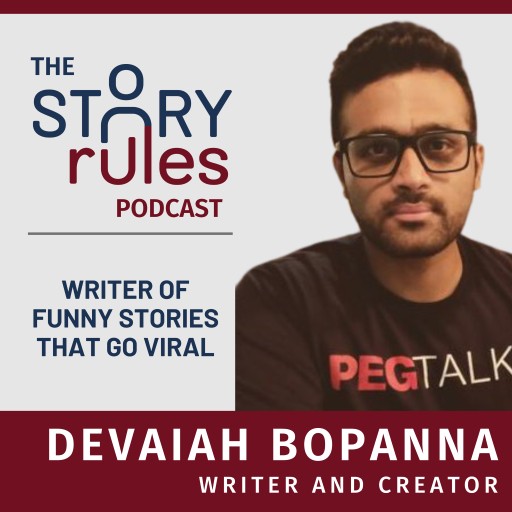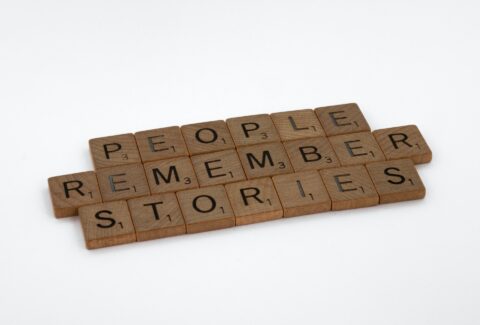E13: Devaiah Bopanna, Writer of funny stories that go viral
This week, I’ve got a podcast episode after ages (man this one has taken time!). And it’s a special guest.
So often at work, when I would get bored, I would press CMD-Tab on my Mac and head off to drown myself in the joys of the internet. Movie reviews on Rediff.com, Sports writing on Cricinfo, and funny videos and trailers on Youtube.
(Of course I was doing all this to learn the art of storytelling)
And on Youtube, while I would watch videos by a variety of creators, perhaps the group that I enjoyed the most was All India Bakchod (or AIB).
For the uninitiated, AIB was a comedy collective which created funny sketches and videos on a variety of topics. Some of their well-known series included:
– The Honest series – a seriously funny take on all experiences from restaurants to flights to engineering campus placements to the Big Fat Indian Wedding
– The Bollywood spoofs: Check out the viral one with Alia Bhatt, or their work with Irrfan
– Political satire: the biting one on the news media or the one on elections
It’s really good stuff. I found the quality of their storytelling so good that I don’t think I’ve missed ANY of their sketches (yep, I even liked the Pista one).
I also liked the fact that AIB would always respect its writers and prominently credit them in their videos (often getting these reticent creators to appear at the end to ask for the mandatory subscribes and likes).
One such writer I noticed in some of those videos was a shy, nerdy looking guy called Devaiah Bopanna. I realised later that he was the Head Writer there.
Cut to – a few years later – I came across some funny posts by Devaiah on an unlikely platform – LinkedIn! And I also learnt that he – along with some AIB stalwarts like Tanmay, Nupur, Vishal, Puneet – have been responsible for the crazy viral CRED ads – including the one featuring Rahul Dravid as Indiranagar ka gunda and Javagal Srinath and Venkatesh Prasad as members of a boy band.
And then I decided that I need to get Devaiah on my podcast to get his take on the craft of storytelling. It took some time, but I’m glad that I persisted.
Devaiah is a multifaceted and thoughtful creator. During the conversation he talks about:
– His curiosity being his biggest learning driver
– Why he would think extra hard about the opening in a story
– How AIB made its stories surprising yet familiar
– The parts of storytelling where he personally struggles with
It’s a fun, insightful conversation. Enjoy!
A small note before we begin: There are parts where Devaiah uses some fairly colourful language. Since this is a show for adults, I’ve chosen to keep them in. But please be mindful in case you are listening with young folks around.
As always, I’m sharing some some lightly-edited extracts from the conversation – tagged under ‘the 3Ps’ – the Personal, Philosophical and the Practical (all emphasis mine):
1. Personal:
a. Curiosity – the key driver of learning
Devaiah did not read many books growing up – but he would consume a lot of newspapers. And his dad made him curious about what was going on behind the news.
Ravi: Can you talk about the early influences that made you veer towards writing? Was it the kind of books that you read? Did you do some early writing when you were in school or college?
Dev: Frankly, no; it’s a little shameful to admit this, but I didn’t read a lot while growing up. I didn’t read books a lot while growing up, (but) my dad is a journalist. And essentially, what would happen is, I would read a lot of newspapers. And I’m not exaggerating, but I think we’d get about six to seven newspapers daily, and we’d get a couple of other newspapers in the evening as well. So, there would just be newspapers at home, and I would read newspapers front to back every day.
Ravi: Wouldn’t that be depressing? Because it’s mostly bad news.
Dev: I think that maybe because I had my dad at home, who would also make this (a) very interesting (activity by) giving me (the) behind the scenes of all the news that was happening. So that context provided a great deal of entertainment when (I was) reading the news. I think, somewhere, that helps. I read a lot of news, and I can probably tell you what happened when Deve Gowda became Prime Minister; I can tell you a lot of things about Karnataka politics, Bangalore politics, or politicians in Bangalore, I’m well versed with those things. That’s because my reading largely centered around politics, sports, and entertainment that came in the newspapers. I didn’t read a great deal. Of course, I read books, but not the amount that my friends, who are writers, used to read when they were young. So, I think reading information (helped), and I think more than information, following your curiosity is a very underrated (thing), you know? Nobody talks about that when they talk about the passion, talent, or those things. It’s usually very easy to say things like writing, music, and everything. I think following curiosity is a skill set. I think that (reading) newspapers and just being hungry for information all the time, and being very open minded about these things shaped me in becoming a writer, perhaps more than reading about stuff. I think those things and curiosity and insights are raw materials that go into writing as the ideas.
2. The Philosophical:
a. Humour is nothing but surprise – the importance of surprising the audience
I was first introduced to the power of ‘surprise’ in storytelling in the classic ‘Made to Stick‘. Its been 12 years since I read the seminal book and I am still awestruck by how powerful it is and how little its impact is understood.
Ravi: There’s a very nice line by Andrew Stanton, who’s a Pixar director; he’s made Finding Nemo and a bunch of other movies. So, it is a famous TED Talk where he starts with a joke, and then he says storytelling is joke telling. It’s all about building up to the punch line. Do you agree that basically when you’re telling a joke or telling something funny, it’s telling a story?
Dev: Yeah, of course! I think Tanmay (Bhat) keeps saying this in the most amazing way, that “humour is nothing but surprise.” A joke is a surprise; you laugh only because you don’t see it coming. It’s totally unpredictable when it hits you. The whole science of joke writing or storytelling, I mean of writing humour, is that you just try to keep hitting people with a funny thought when they least see it coming. You have to keep building smart decoys, and smart ways to conceal your joke and then lead people down a (certain) way and then hit them with the joke. Basically, I think a good story and narrative is what you need to land good jokes. So, I completely agree with him. It’s a completely genuine thought.
b. Creativity works under constraints
Which are the most creative professions?
You might definitely slot advertising at the top of that list. You’d think that ad folks are constantly told to “think outside the box”
Guess what, not true.
Ravi: When you moved from advertising to AIB, I heard you saying in another podcast that there was a fairly intense period of unlearning, because you’d been used to doing things in a certain way and here things were done in a different way. Could you unpack some of that? You know, what are some of the skills that you had to unlearn and what were the new skills that you had to pick up?
Dev: Sure. I think the biggest skill (that I had to unlearn) is that advertising trains you to think inside the box.
Ravi: Really?! I mean, isn’t it supposed to be creative?
Dev: That’s what it looks like, but you have a brief, then you have brand guidelines, then you even have (instructions) like “you have to use this line”. Sometimes “you have to use these characters; you can’t talk about ‘x’, you can’t talk about ‘y’, you can’t talk about ‘z’.” Then they’re like, “Okay, after all this, now go crazy.”
Ravi: Oh, there was this AIB sketch, I think #AskAIB 1 or 2, where Rohan was doing this with another guy. I remember this.
Dev: It’s pretty much like that, right? You essentially rip everyone’s wings off, and you tell them “Now fly.” Which is a great skill set, you know, no undermining that.
Ravi: So you’re saying that even within those constraints, if somebody is able to do something creative then that’s great.
Dev: Yeah, that is insane. That’s why I respect really good advertising work, because I know what happens behind the scenes.
c. The need to be brutally honest when giving feedback and thick skinned when receiving it
I’ll admit: I’m not very comfortable receiving negative feedback delivered in a very brusque, no-nonsense way.
But in the world of advertising and funny videos, ideas fly thick and fast and there isn’t enough time to be diplomatic about your feedback. Dev gives us tips on how to give and receive feedback, the importance of being open to rejection… and the criticality of trust within the team to be honest with each other.
Ravi: One thing I’m really curious about, which I have personally struggled with a little bit, when it comes to anything creative …, when I have to discuss ideas with other people, it’s always been a struggle. Because different people will have different opinions, as it should be. And then to be able to love your idea, to give it birth, and yet be detached enough from it to see it getting massacred…It’s a tough one. How do you build that muscle? How do you manage creativity in a group?
Dev: One thing is that you need to be very self-critical, because I see a lot of people that are in love with their ideas, they get married to their ideas, and that is doomsday for you. Because a lot of people can’t get over the fact that their idea is sh*t. You need to be at least (a little self-critical); I think we all are trained to be very, super self-critical in the first place. And we are, ourselves, unsure.
Ravi: How do you get that training to be self-critical? That’s not easy.
Dev: I think advertising teaches you that, because you have a boss and they’ll be like, “No, this is sh*t”, you can’t argue with her, you just have to go back and do it (right). And then you do that, and you go to the client, because someone who’s putting a lot of money into your ideas will be extra critical. So they’ll be like, “No, this is bullsh*t ; this is not happening.” So, you’re basically trained for rejection, again and again. Most of the ideas we think of, won’t happen; there’s a small minority of things that actually happen. A big majority, or most of the things you have ideas for, are going to get rejected. So, I think that rejection (helps to be self-critical), I mean, I don’t take it to heart; I know a lot of people in my life who don’t take it to heart. As far as thinking (creatively in a group goes,) there’s a lot of trust over there. That is the most critical thing, creating a safe space, where you’ll know your idea’s getting killed only because it is a bad idea, not because of an ego or insecurity that is killing your idea, which also happens a lot when you’re thinking in a group, or if you’re in the wrong group, or if you have an insecure boss or teammate. Those are places where you feel very unsafe. And that’s probably why I worked only with (very specific people) in the last few years, we work with each other in our team the most. I hardly collaborate – at least writing wise – I don’t collaborate so much with somebody who is completely new, or anything like that, because there is a lot of trust and faith over here. When I say an idea or when someone tells me an idea, and I tell them it’s sh*t, in as many words, because we also have deadlines, you can’t always be very diplomatic about it. If every time someone gives a bad idea, if you have to sit and explain to them why it’s a bad idea, it becomes a huge waste of time. So, most of the times you’re curt, you’re like, “No, that’s sh*t, it’s f***all, let’s move on.” So, when you’re giving an idea, that’s the exact reaction you get if it’s a bad idea. Now, you can’t take that to heart, and especially in a group where you are fully familiar with (the fact that) it’s coming from only the merit for the idea.
3. The Practical
a. Start strong – put extra effort into your opening
The beginning of a story is the most important part. If you start strong, there’s a much higher chance that your audience will stay with you for the duration of the story.
Ravi: I want to now talk about some specific work that you and your team have done, Dev, and unpack some of the story tools that have been used. I’m going to pick this series, that had a couple of videos, which is called Honest House Parties. It’s about how youngsters have house parties and what happens in them. So in this, the first minute of the eight-minute sketch is an opening conversation between a broker and two youngsters who are looking for a house on rent in Bombay – the most difficult city in the country to get a house on rent in.
That one-minute opening is so strong because it just sets the tone, and you do the opening and then there is the announcement of the name of the video. I love that opening, it’s a great lesson for storytellers like us at the workplace, that if you’ve got a big presentation to be made to an audience, think extra hard about the opening. How do you plan to open? Will it be – of course, not with a joke, but maybe with an interesting stat, or would it be with a personal story? Will it be with a question? And so on.
I want to talk to you about how you guys approached openings. Was it something where you’d say, “Okay, let’s lay out the opening first”? or you just throw a bunch of ideas out and then figure it out, like “Okay, let’s start with this.”
Dev: You know, what you said is absolutely right. We put so much effort into it. We call it the ‘cold open’. The scene before the title comes in is the ‘cold open’; and the cold open is the most important part of anything that you do on YouTube, because YouTube is just unforgiving. You’re competing with an algorithm that has no emotions. So basically, if your first 30 seconds are weak, the viewer will automatically shut the video and go somewhere else. Honestly, I think the first one minute has to be the strongest (part) in the video to make sure that everything that you do lands, and it also sets context to what is coming up. There’s no point in having a great video that is eight minutes long, which picks up on the second minute, but the first two minutes is just building up (to the joke). Unfortunately, as much as we all love to indulge, the algorithm won’t let you do that. At least, back then (it wouldn’t have). We would think really hard on the cold open.
b. Nothing like a good deadline to get the creative juices flowing
A lot of creative folks swear by their reflection practices. Some people go on walks, some cycle (I do), while some may need to hit the pool.
Devaiah does not have the luxury of these indulgences.
Ravi: So you’re consuming a lot of this good content, and sometimes going down rabbit holes and all that fun. But then now, say you get a brief, and you have to come up with ideas, where do you get your best ideas?
Dev: In those times, I usually switch off my laptop and think. Obviously, I do a lot of research, if it’s a product, to find out what the products do and everything. And then it’s just thinking up ideas and looking at what someone has done in that space internationally, and in India; What is good, what is bad; so, your yardstick is set. And then you emulate those pieces of content with your work. And take it from there.
Ravi: Do you have a deliberate process like walking, or going for a cycle ride, or something like that to generate ideas?
Dev: Not really. The thing is, because I’ve always been in the commercial art (field), where there’s a deadline looming over (your head), I don’t have the pleasure of taking my own sweet time or having these things; being like “only if I walk or cycle, I will get ideas”. I can’t do it because my income depends on these things. So, it’s constantly just skipping from one brief to another in this room, or wherever I am. And thinking, writing, experimenting; writing out something, then going “Ah yeah, this is fine,” deleting; So that is the process. There’s, unfortunately, no nice, romanticized way of doing it for me.
Ravi: There’s this famous Calvin and Hobbes cartoon, where Hobbes is telling him, “You need to submit some report” he says “I can’t just do it whenever I want, I need to get the right time and the right place for inspiration will strike.”
“What is the right time and place?” he asks, and Calvin says, “Last minute panic.”
So, yeah, I think we need that push and the deadline to make things work.
And those were some highlights from the conversation with Devaiah Bopanna, an extraordinary comic writer who’s entertained us and yet managed to deliver strong messages through his work.
A few things which stayed with me:
– Why it is actually very difficult to be truly creative in advertising given the constraints… and
– How sometimes when there are no constraints, it’s not easy to open the creativity tap and let it flow, and finally
– When ideating, why it is important to be brutally honest when giving feedback and thick skinned when receiving it
You can enjoy my conversation with Devaiah at your favourite podcast location:
Browser
Podcast apps: Apple Podcasts | Spotify | Google Podcasts | Stitcher | Podcast Addict | Pocket Casts
Happy listening!
If you find the content valuable, please rate and review this podcast on iTunes, Spotify, Google Podcasts, or wherever you listen to them (links above). It’ll help others like you discover these insights!
This podcast was hosted by me, Ravishankar Iyer. Audio editing by Kartik Rajan. Transcript editing by Amisha Jha and all-round support by Sanket Aalegaonkar.
Thanks,
Ravi








